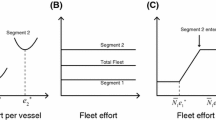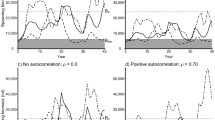Abstract
The Pacific whiting (Merluccius productus) is a highly migratory fish occupying the continental shelf and slope off the west coast of North America. The species spawns in January off southern California and northern Mexico. During spring and summer the older and larger fish will migrate as far north as central Vancouver Island. Recruitment is highlys variable, with strong year classes often supporting the commercial fishery during several years of low recruitment. The level of recruitment appears to be independent of the size of the spawning population.
A simple bioeconomic model of the Pacific whiting is constructed with independent recruitment. Fishery production functions are estimated from data on U.S. catch, average annual biomass and the number of vessels in the U.S. fleet. A stochastic optimization problem, seeking to maximize the expected value of industry profit, is formulated. Its solution would require a joint distribution on future recruiment and other bioeconomic parameters. Such a distribution is problematic. As an alternative, the certainty-equivalent problem is solved yielding solution values for the stochastic equilibrium and an approximately-optimal rule that sets allowable catch based on an estimate of current-year biomass.
Adaptive management can result in large changes in fleet size and allowable catch from year to year. The whiting fishery might be characterized as an opportunistic fishery, requiring a generalist fleet to expand or contract as bioeconomic conditions warrant. It is possible that longrun conditions would not support a profitable fishery, but that short-run fishing is profitable based on previous years of strong recruitment. The situation is not dissimilar to that facing the owner of a marginal gold mine that opens or closes depending on the price of gold. In the case of the whiting fishery, the optimal level of short-run fishing will depend not only on price, but on current biomass, the annual cost of fishing, the discount rate and vessel productivity. A simple interactive program is provided for would-be managers.
Similar content being viewed by others
Literature
Bailey, K. M. 1981. Larval transport and recruitment of Pacific hakeMerluccius productus Mar. Ecol. Prog. Ser. 6, 1–9.
Bailey, K. M., R. C. Francis and P. R. Stevens. 1982. The life history and fishery of Pacific whiting,Merluccius productus.Calif. Coop. Oceanic Fish. Invest. 23, 81–98.
Burt, O. R. 1964. Optimal resource use over time with an application to groundwater.Mgmt Sci. 11, 80–93.
Burt, O. R. 1967. Temporal allocation of groundwater.Water Resources Res. 3, 45–56.
Burt, O. R. and R. G. Cummings. 1977. Natural resource management, the steady state and approximately optimal decision rules.Land Econ. 53, 1–22.
Conrad, J. M. and C. W. Clark. 1987.Natural Resource Economics: Notes and Problems. Cambridge, U.K.: Cambridge University Press.
Dorn, M. W. and R. D. Methot. 1989. Status of the Pacific whiting resource in 1989 and recommendations to management in 1990. InStatus of the Pacific Coast Groundfish Fishery Through 1989 and Recommended Acceptable Biological Catches for 1990, pp. A.1-A.61. Portland, Oregon: Pacific Fishery Management Council.
Francis, R. C. 1983. Population and trophic dynamics of Pacific hake (Merluccius productus).Can. J. Fish. Aquatic Sci. 40, 1925–1943.
Kolberg, W. C. 1990.Approach Paths to the Steady State: A Performance Test of Current Period Decision Rule Solution Methods for Models of Renewable Resource Management. Ithaca, New York: Working Paper, Department of Economics, Ithaca College.
Squires, D. E. 1990. Notes on the economics of the Pacific whiting fishery. Fax transmission, Southwest Fisheries Center, 18 June 1990.
Swartzman, G. L., W. M. Getz and R. C. Francis. 1983. A management analysis of the Pacific whiting (Merluccius productus) fishery using an age-structured stochastic recruitment model.Can. J. Fish. Aquatic Sci. 40, 524–539.
Swartzman, G. L., W. M. Getz and R. C. Francis. 1987. Binational management of Pacific hake (Merluccius productus): a stochastic modeling approach.Can. J. Fish. Aquatic Sci. 44, 1053–1063.
Author information
Authors and Affiliations
Additional information
This paper was written in July 1990 while the author was a Summer Faculty Fellow at the Southwest Fisheries Center, La Jolla, California. The author gratefully acknowledges the support of the U.S. National Marine Fisheries Service.
Rights and permissions
About this article
Cite this article
Conrad, J.M. A bioeconomic model of the pacific whiting. Bltn Mathcal Biology 54, 219–239 (1992). https://doi.org/10.1007/BF02464831
Received:
Revised:
Issue Date:
DOI: https://doi.org/10.1007/BF02464831




